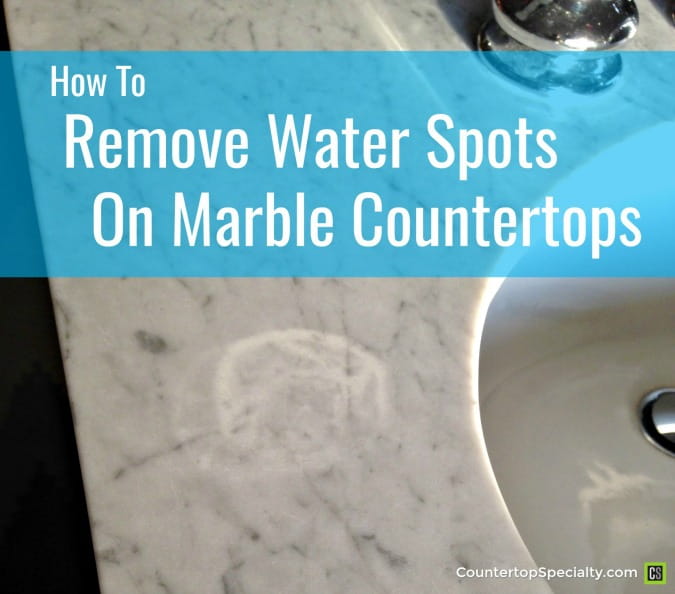Marble Vanity Top Water Spots
QUESTION:
I have a polished marble vanity top in my guest bath and honed marble countertops in my kitchen.
I have a lot water spots that I can't seem to get clean.
Do you have any suggestions?

ANSWER:
"Water spots" and dull spots on marble vanity tops or countertops are a common marble repair issue (on both honed and polished surfaces); however, they are not caused by water.
The dull spots are etch marks caused by acidic foods, drinks, and cleaners.
They may look lighter, clear or the same color as your marble. And on lighter marble colors, you may only notice the spots from certain viewing angles or depending on the light hitting the surface.
The etch spots happen from spills, but are often seen as drips or drops or spray marks from using the wrong cleaner. Or as a circle from a cup or glass.
The reason this happens is that marble is composed of calcite and reacts chemically with acidic substances like wine, coffee, juice, fruit, soda, alcoholic drinks and many (most) cleaning products that come in contact with your marble vanity top.
Thus, it's best to use only marble-safe cleaning products.
The acidic/caustic reaction "etches" or corrodes the surface ruining the polish (or smooth honed surface) causing the appearance of the lighter-colored dull spots.
You will notice this most on polished marble floor tile and countertops. Marble vanity tops and tiles that are honed or have a matte surface still react and will etch, but you may not see the result --dull spot-- as well because the surface is already somewhat dull.... not reflective like a polished marble.
Solution(s) to restore dull spots / water spots....
Your marble vanity top has, in effect, been de-polished. Polishing is accomplished by friction. Polishing is what makes the marble shiny so in order to restore the shine and "remove" the spots you'll need to follow one of the 3 options below.
Option 1: Use a special marble polishing compound to restore the
If this doesn't work, then you have severe etch marks. Severe etching is rare.... most etch marks are not severe.
But if the damage is rough-to-the-touch and option 1 doesn't fix it, then you must resort to the following two options, which are much more expensive.
Option 2: Hire a professional to re-polish your marble.
Of course, this will not prevent the same problem from occurring again and sealing does not address this problem. It won't stop etching.
Option 3: Remove the polish with an acid wash or have the surface "honed" (requires a professional). A "honed" finish is smooth, but not shiny. "Water spots" still occur, but aren't as noticeable on a honed surface.
But then again, restoring etch marks on a polished surface is arguably easier to do with the Etch Remover product mentioned above vs. repairing etch marks on a honed surface.
Restoring honed marble etch marks is different than on a "polished" finish. Unfortunately, there's no product to use. However, the fix is cheap and relatively easy. Complete instructions provided in the Restoring Marble Etching e-book.
In my house, we always use coasters and trays on our bathroom marble countertops to avoid etching.
A marble sealer may still be necessary to protect against stains: substances that are absorbed into and darken the stone.
But this depends on the particular slab. Again, marble is typically highly resistant to staining and many varieties are so dense that they do not absorb liquids and do not need and should not have a sealer applied.
If you have a spot that is a different color or darker than your marble vanity top color then you have a "stain" which requires a completely different approach.
If this is the case.... go to the marble stains page to learn about and find remedies to that particular problem.
Comments for Marble Vanity Top Water Spots
|
||
|
||
|
||
|
||
|
||
|
||
|
||
|
||
|
||
|
||
|
||
|
||
|
||


